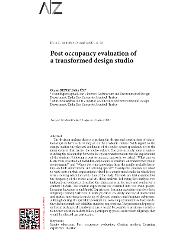| dc.contributor.author | Kepez, Orçun | |
| dc.date.accessioned | 2020-08-26T11:05:50Z | en_US |
| dc.date.available | 2020-08-26T11:05:50Z | en_US |
| dc.date.issued | 2017 | en_US |
| dc.identifier.issn | 2564-7474 | en_US |
| dc.identifier.issn | 2564-7474 | en_US |
| dc.identifier.uri | https://hdl.handle.net/20.500.12469/3265 | |
| dc.identifier.uri | https://search.trdizin.gov.tr/yayin/detay/312513 | |
| dc.description.abstract | The decision-makers choices regarding the design and construction of educational spaces have a direct impact on the academic culture. With regard to the
design studios, the physical conditions of the studio spaces specifically act as the
main element that creates the studio culture. The present study aims at understanding the relationship between the spatial transformation and the expectations
of the students. Following a post occupancy approach, we asked, “What can we
learn from collection of individual evaluations of students’ on transformed studio
environment?” and “Where does this knowledge fit in the readily available literature on built environment and learning spaces?” Twenty-five students are asked
to write texts on their expectations related to a transformed studio in which they
were receiving education at the time of the study. The texts are first examined for
the frequency of the words used via cloud analysis. Following that analysis, two
independent evaluators identified the phenomena in the texts and conducted a
content analysis. The student expectations are classified into two main groups:
Learning Experiences and Spatial Experiences. Learning experience involves three
subgroups namely variation in work practices, creativity and social interactions
and spatial experience is made up of physical comfort and furniture subgroups.
Although during the spatial transformation, some improvement have been made,
they did not completely fulfill the students’ expectations. The present study proposes that in such spatial transformations, it would be possible to attain user satisfaction when decision-makers follow participatory processes in which all groups that
would be effected can participate. | en_US |
| dc.language.iso | eng | en_US |
| dc.publisher | İstanbul Teknik Üniversitesi | en_US |
| dc.rights | info:eu-repo/semantics/openAccess | en_US |
| dc.subject | Studio education | en_US |
| dc.subject | Post occupancy evaluation | en_US |
| dc.subject | Content analysis | en_US |
| dc.subject | Learning experience | en_US |
| dc.subject | Interior | en_US |
| dc.title | Post occupancy evaluation of a transformed design studio | en_US |
| dc.type | article | en_US |
| dc.identifier.startpage | 41 | en_US |
| dc.identifier.endpage | 52 | en_US |
| dc.relation.journal | A|Z ITU Mimarlık Fakültesi Dergisi | en_US |
| dc.identifier.issue | 3 | en_US |
| dc.identifier.volume | 14 | en_US |
| dc.department | Fakülteler, Sanat ve Tasarım Fakültesi, İç Mimarlık ve Çevre Tasarımı Bölümü | en_US |
| dc.institutionauthor | Kepez, Orçun | en_US |
| dc.relation.publicationcategory | Makale - Ulusal Hakemli Dergi - Kurum Öğretim Elemanı | en_US |
| dc.identifier.trdizinid | 312513 | en_US |
















